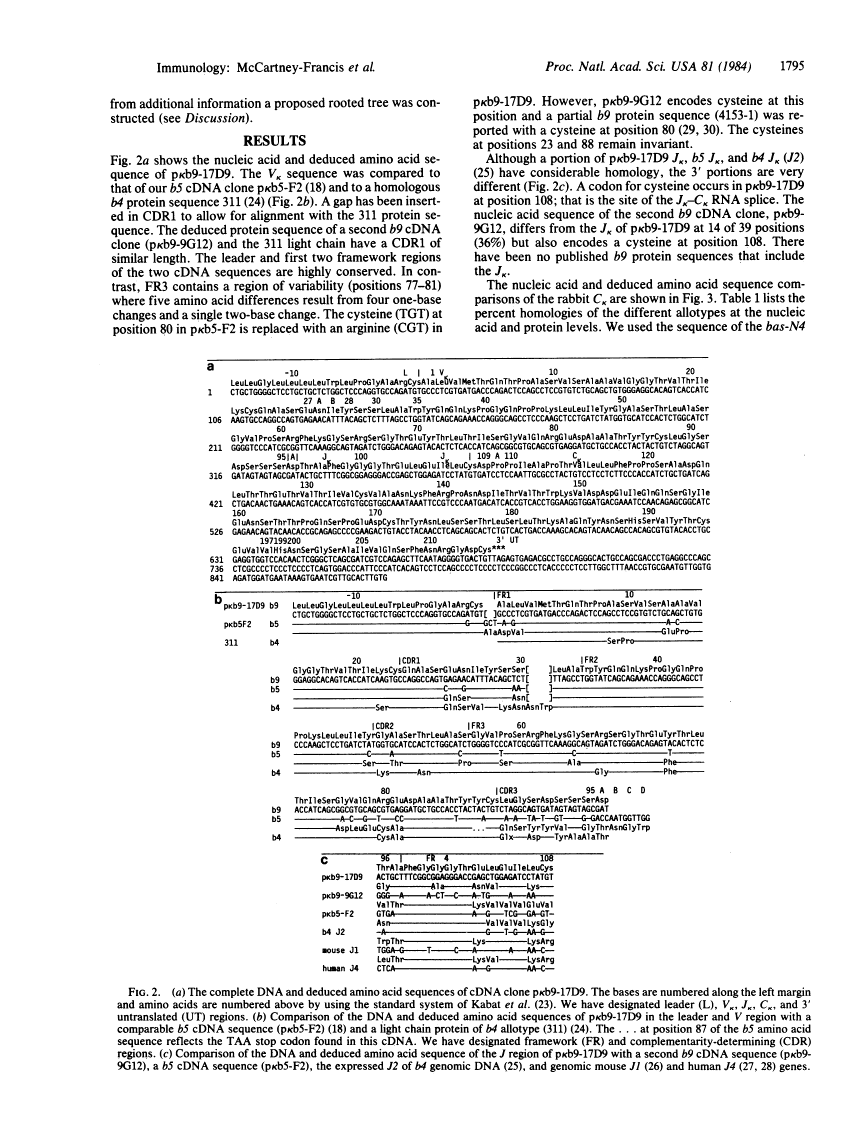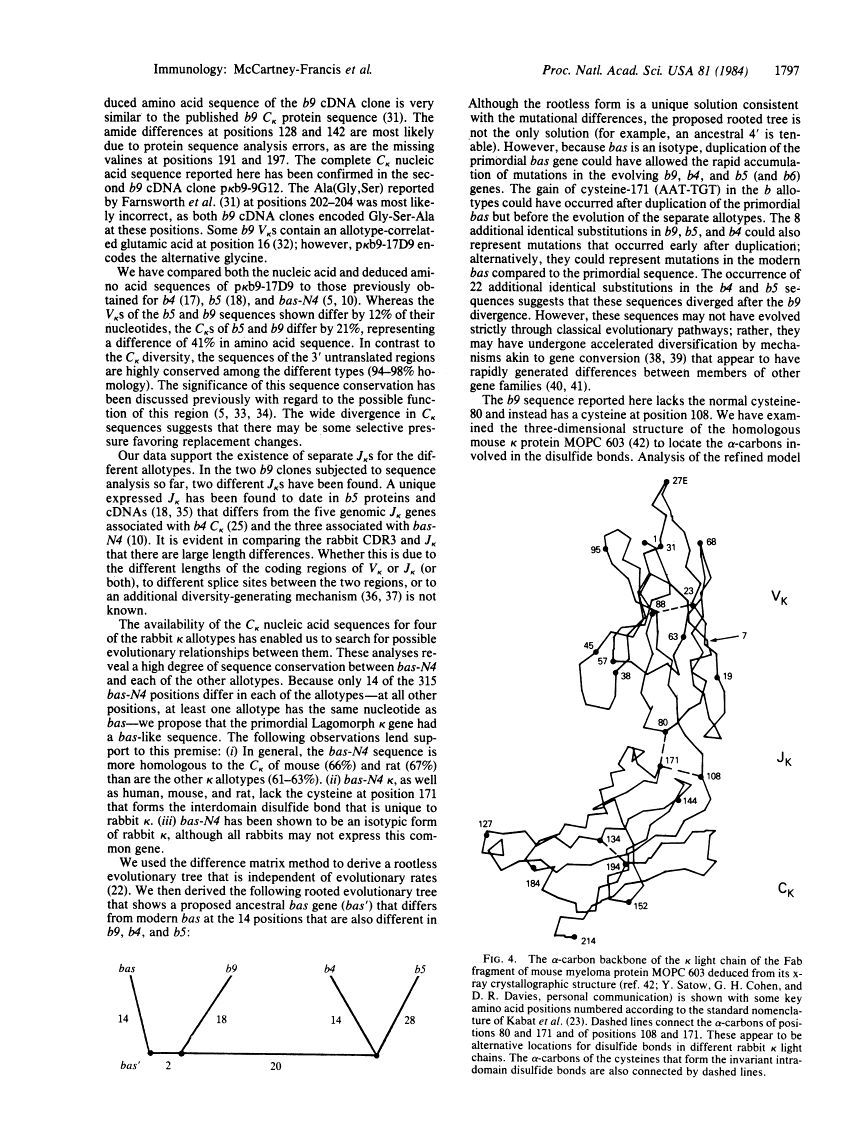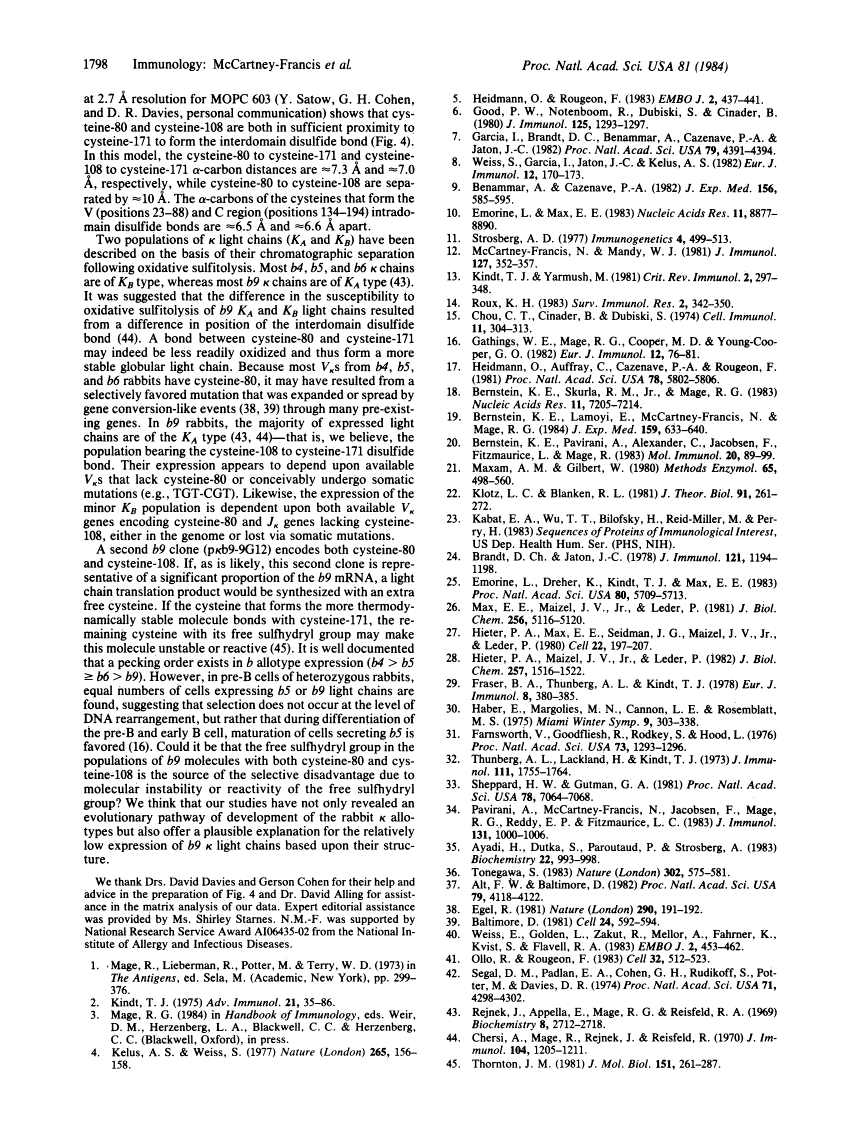Abstract
Free full text

Kappa-chain allotypes and isotypes in the rabbit: cDNA sequences of clones encoding b9 suggest an evolutionary pathway and possible role of the interdomain disulfide bond in quantitative allotype expression.
Abstract
The constant regions of rabbit kappa light chains are unusual because the sequences of the allotypic forms can differ more from each other than do some variable regions with which they associate. We report the nucleic acid sequence of a full-length cDNA clone of b9 allotype and show comparisons to available sequences of the rabbit kappa allotypes b4, b5, and bas-N4. Our analyses suggest that the primordial rabbit kappa gene encoded a bas-like sequence. They also reveal a surprising difference in the position of the variable region cysteine that forms the interdomain disulfide bond that is unique to most rabbit kappa chains. One b9 cDNA sequence lacks the usual cysteine-80 and instead encodes cysteine-108, which in three-dimensional models appears capable of forming the interdomain disulfide bond with cysteine-171 in the constant region. A partial sequence of a second b9 clone encodes both cysteine-80 and cysteine-108; the translation product of this clone could have a free reactive sulfhydryl group that might lead to an unstable nonfunctional Ig molecule. The fact that pre-B cells with b9 kappa chains do not differentiate and expand into productive Ig-producing cells with frequencies comparable to the other allotypes may be explained if a substantial proportion of the gene products have a free sulfhydryl group. Our sequence results suggest that in cells differentiating to produce kappa light chains of b9 allotype the number and location of the cysteines influence immunoglobulin expression.
Full text
Full text is available as a scanned copy of the original print version. Get a printable copy (PDF file) of the complete article (1.0M), or click on a page image below to browse page by page. Links to PubMed are also available for Selected References.
Selected References
These references are in PubMed. This may not be the complete list of references from this article.
- Kindt TJ. Rabbit immunoglobulin allotypes: structure, immunology, and genetics. Adv Immunol. 1975;21:35–86. [Europe PMC free article] [Abstract] [Google Scholar]
- Kelus AS, Weiss S. Variant strain of rabbits lacking immunoglobulin kappa polypeptide chain. Nature. 1977 Jan 13;265(5590):156–158. [Abstract] [Google Scholar]
- Heidmann O, Rougeon F. Multiplicity of constant kappa light chain genes in the rabbit genome: a b4b4 homozygous rabbit contains a kappa-bas gene. EMBO J. 1983;2(3):437–441. [Europe PMC free article] [Abstract] [Google Scholar]
- Good PW, Notenboom R, Dubiski S, Cinader B. Basilea rabbit immunoglobulins: detection and characterization by specific alloantiserum. J Immunol. 1980 Sep;125(3):1293–1297. [Abstract] [Google Scholar]
- Garcia I, Brandt DC, Benammar A, Cazenave PA, Jaton JC. BASILEA rabbits express two types of immunoglobulin light chains: lambda and kappa-like. Proc Natl Acad Sci U S A. 1982 Jul;79(14):4391–4394. [Europe PMC free article] [Abstract] [Google Scholar]
- Weiss S, Garcia I, Jaton JC, Kelus AS. Allotypes in Basilea rabbits. Eur J Immunol. 1982 Feb;12(2):170–173. [Abstract] [Google Scholar]
- Benammar A, Cazenave PA. A second rabbit kappa isotype. J Exp Med. 1982 Aug 1;156(2):585–595. [Europe PMC free article] [Abstract] [Google Scholar]
- Emorine L, Max EE. Structural analysis of a rabbit immunoglobulin kappa 2 J-C locus reveals multiple deletions. Nucleic Acids Res. 1983 Dec 20;11(24):8877–8890. [Europe PMC free article] [Abstract] [Google Scholar]
- McCartney-Francis N, Mandy WJ. Control of latent allotype expression by rabbit splenocytes. J Immunol. 1981 Jul;127(1):352–357. [Abstract] [Google Scholar]
- Roux KH. Rabbit latent allotypes: current status and future directions. Surv Immunol Res. 1983;2(4):342–350. [Abstract] [Google Scholar]
- Chou CT, Cinader B, Dubiski S. Unequal expression of allelic allotypic specificities in circulating immunoglobulins, experimentally-elicited antibodies, and receptor-carrying cells. Cell Immunol. 1974 Mar 30;11(1-3):304–313. [Abstract] [Google Scholar]
- Gathings WE, Mage RG, Cooper MD, Young-Cooper GO. A subpopulation of small pre-B cells in rabbit bone marrow expresses kappa light chains and exhibits allelic exclusion of b locus allotypes. Eur J Immunol. 1982 Jan;12(1):76–81. [Abstract] [Google Scholar]
- Heidmann O, Auffray C, Cazenave PA, Rougeon F. Nucleotide sequence of constant and 3' untranslated regions of a kappa immunoglobulin light chain mRNA of a homozygous b4 rabbit. Proc Natl Acad Sci U S A. 1981 Sep;78(9):5802–5806. [Europe PMC free article] [Abstract] [Google Scholar]
- Bernstein KE, Skurla RM, Jr, Mage RG. The sequences of rabbit kappa light chains of b4 and b5 allotypes differ more in their constant regions than in their 3' untranslated regions. Nucleic Acids Res. 1983 Oct 25;11(20):7205–7214. [Europe PMC free article] [Abstract] [Google Scholar]
- Bernstein KE, Lamoyi E, McCartney-Francis N, Mage RG. Sequence of a cDNA encoding Basilea kappa light chains (K2 isotype) suggests a possible relationship of protein structure to limited expression. J Exp Med. 1984 Feb 1;159(2):635–640. [Europe PMC free article] [Abstract] [Google Scholar]
- Bernstein KE, Pavirani A, Alexander C, Jacobsen F, Fitzmaurice L, Mage R. Use of Trypanosoma equiperdum infected rabbits as a source of splenic mRNA; construction of cDNA clones and identification of a rabbit mu heavy chain clone. Mol Immunol. 1983 Jan;20(1):89–99. [Abstract] [Google Scholar]
- Maxam AM, Gilbert W. Sequencing end-labeled DNA with base-specific chemical cleavages. Methods Enzymol. 1980;65(1):499–560. [Abstract] [Google Scholar]
- Klotz LC, Blanken RL. A practical method for calculating evolutionary trees from sequence data. J Theor Biol. 1981 Jul 21;91(2):261–272. [Abstract] [Google Scholar]
- Brandt DC, Jaton JC. Identical VL region sequences of two antibodies from two outbred rabbits exhibiting complete idiotypic cross-reactivity and probably the same antigen-binding site fine structure. J Immunol. 1978 Sep;121(3):1194–1198. [Abstract] [Google Scholar]
- Emorine L, Dreher K, Kindt TJ, Max EE. Rabbit immunoglobulin kappa genes: structure of a germline b4 allotype J-C locus and evidence for several b4-related sequences in the rabbit genome. Proc Natl Acad Sci U S A. 1983 Sep;80(18):5709–5713. [Europe PMC free article] [Abstract] [Google Scholar]
- Max EE, Maizel JV, Jr, Leder P. The nucleotide sequence of a 5.5-kilobase DNA segment containing the mouse kappa immunoglobulin J and C region genes. J Biol Chem. 1981 May 25;256(10):5116–5120. [Abstract] [Google Scholar]
- Hieter PA, Max EE, Seidman JG, Maizel JV, Jr, Leder P. Cloned human and mouse kappa immunoglobulin constant and J region genes conserve homology in functional segments. Cell. 1980 Nov;22(1 Pt 1):197–207. [Abstract] [Google Scholar]
- Hieter PA, Maizel JV, Jr, Leder P. Evolution of human immunoglobulin kappa J region genes. J Biol Chem. 1982 Feb 10;257(3):1516–1522. [Abstract] [Google Scholar]
- Fraser BA, Thunberg AL, Kindt TJ. Variable region correlates of group b allotypes: amino acid sequence studies of b9 L chains from homogeneous antibodies. Eur J Immunol. 1978 Jun;8(6):380–385. [Abstract] [Google Scholar]
- Farnsworth V, Goodfliesh R, Rodkey S, Hood L. Immunoglobulin allotypes of rabbit kappa chains: polymorphism of a control mechanism regulating closely linked duplicated genes? Proc Natl Acad Sci U S A. 1976 Apr;73(4):1293–1296. [Europe PMC free article] [Abstract] [Google Scholar]
- Thunberg AL, Lackland H, Kindt TJ. Sequence variations in b9 light chains as potential V region genetic markers. J Immunol. 1973 Dec;111(6):1755–1764. [Abstract] [Google Scholar]
- Sheppard HW, Gutman GA. Allelic forms of rat kappa chain genes: evidence for strong selection at the level of nucleotide sequence. Proc Natl Acad Sci U S A. 1981 Nov;78(11):7064–7068. [Europe PMC free article] [Abstract] [Google Scholar]
- Pavirani A, McCartney-Francis N, Jacobsen F, Mage RG, Reddy EP, Fitzmaurice LC. Analyses of the splenic mRNA expressed by rabbits of different immunoglobulin kappa-light chain allotypes: conserved sequences in the 3' untranslated region and allotype-specific probes. J Immunol. 1983 Aug;131(2):1000–1006. [Abstract] [Google Scholar]
- Ayadi H, Dutka S, Paroutaud P, Strosberg AD. Partial amino acid sequence of a rabbit immunoglobulin light chain of allotype b5. Biochemistry. 1983 Feb 15;22(4):993–998. [Abstract] [Google Scholar]
- Tonegawa S. Somatic generation of antibody diversity. Nature. 1983 Apr 14;302(5909):575–581. [Abstract] [Google Scholar]
- Alt FW, Baltimore D. Joining of immunoglobulin heavy chain gene segments: implications from a chromosome with evidence of three D-JH fusions. Proc Natl Acad Sci U S A. 1982 Jul;79(13):4118–4122. [Europe PMC free article] [Abstract] [Google Scholar]
- Egel R. Intergenic conversion and reiterated genes. Nature. 1981 Mar 19;290(5803):191–192. [Abstract] [Google Scholar]
- Baltimore D. Gene conversion: some implications for immunoglobulin genes. Cell. 1981 Jun;24(3):592–594. [Abstract] [Google Scholar]
- Weiss E, Golden L, Zakut R, Mellor A, Fahrner K, Kvist S, Flavell RA. The DNA sequence of the H-2kb gene: evidence for gene conversion as a mechanism for the generation of polymorphism in histocompatibilty antigens. EMBO J. 1983;2(3):453–462. [Europe PMC free article] [Abstract] [Google Scholar]
- Ollo R, Rougeon F. Gene conversion and polymorphism: generation of mouse immunoglobulin gamma 2a chain alleles by differential gene conversion by gamma 2b chain gene. Cell. 1983 Feb;32(2):515–523. [Abstract] [Google Scholar]
- Segal DM, Padlan EA, Cohen GH, Rudikoff S, Potter M, Davies DR. The three-dimensional structure of a phosphorylcholine-binding mouse immunoglobulin Fab and the nature of the antigen binding site. Proc Natl Acad Sci U S A. 1974 Nov;71(11):4298–4302. [Europe PMC free article] [Abstract] [Google Scholar]
- Rejnek J, Appella E, Mage RG, Reisfeld RA. Subtypes of rabbit kappa light polypeptide chains associated with the beta locus. Biochemistry. 1969 Jul;8(7):2712–2718. [Abstract] [Google Scholar]
- Chersi A, Mage R, Rejnek J, Reisfeld R. Isolation, chemical and immunologic characterization of kappa and lambda-type light chains from IgG of normal rabbits with b9 allotype. J Immunol. 1970 May;104(5):1205–1211. [Abstract] [Google Scholar]
- Thornton JM. Disulphide bridges in globular proteins. J Mol Biol. 1981 Sep 15;151(2):261–287. [Abstract] [Google Scholar]
Associated Data
Articles from Proceedings of the National Academy of Sciences of the United States of America are provided here courtesy of National Academy of Sciences
Full text links
Read article at publisher's site: https://doi.org/10.1073/pnas.81.6.1794
Read article for free, from open access legal sources, via Unpaywall:
https://www.pnas.org/content/pnas/81/6/1794.full.pdf
Citations & impact
Impact metrics
Citations of article over time
Alternative metrics
Smart citations by scite.ai
Explore citation contexts and check if this article has been
supported or disputed.
https://scite.ai/reports/10.1073/pnas.81.6.1794
Article citations
Experimental Structures of Antibody/MHC-I Complexes Reveal Details of Epitopes Overlooked by Computational Prediction.
J Immunol, 212(8):1366-1380, 01 Apr 2024
Cited by: 1 article | PMID: 38456672 | PMCID: PMC10982845
Rabbit derived VL single-domains as promising scaffolds to generate antibody-drug conjugates.
Sci Rep, 13(1):4837, 24 Mar 2023
Cited by: 2 articles | PMID: 36964198 | PMCID: PMC10038998
Structural basis for differential recognition of phosphohistidine-containing peptides by 1-pHis and 3-pHis monoclonal antibodies.
Proc Natl Acad Sci U S A, 118(6):e2010644118, 01 Feb 2021
Cited by: 8 articles | PMID: 33547238 | PMCID: PMC8017925
Roles of the disulfide bond between the variable and the constant domains of rabbit immunoglobulin kappa chains in thermal stability and affinity.
Protein Eng Des Sel, 31(7-8):243-247, 01 Jul 2018
Cited by: 6 articles | PMID: 29850878
Decoding Selection Bias Imparted by Unpaired Cysteines: a Tug of War Between Expression and Affinity.
Appl Biochem Biotechnol, 185(3):778-785, 12 Jan 2018
Cited by: 0 articles | PMID: 29330770
Go to all (34) article citations
Data
Similar Articles
To arrive at the top five similar articles we use a word-weighted algorithm to compare words from the Title and Abstract of each citation.
Identification of rabbit immunoglobulin latent Ckappa1 allotype genes alters the concept of allelic inheritance.
Mol Immunol, 35(14-15):965-976, 01 Oct 1998
Cited by: 0 articles | PMID: 9881692
Sequence of a cDNA encoding Basilea kappa light chains (K2 isotype) suggests a possible relationship of protein structure to limited expression.
J Exp Med, 159(2):635-640, 01 Feb 1984
Cited by: 20 articles | PMID: 6420504 | PMCID: PMC2187219
A genomic gene encoding the b5 rabbit immunoglobulin kappa constant region: implications for latent allotype phenomenon.
Proc Natl Acad Sci U S A, 81(6):1789-1793, 01 Mar 1984
Cited by: 14 articles | PMID: 6424123 | PMCID: PMC345006
The structural and genetic basis for expression of normal and latent VHa allotypes of the rabbit.
Mol Immunol, 21(11):1067-1081, 01 Nov 1984
Cited by: 45 articles | PMID: 6083445
Review










